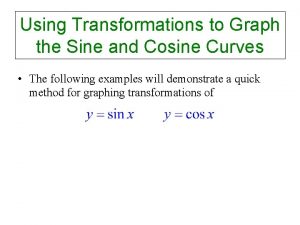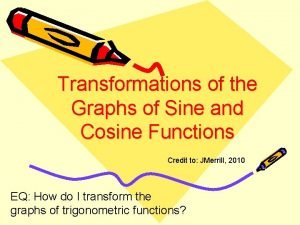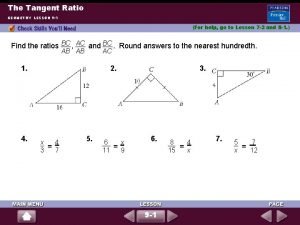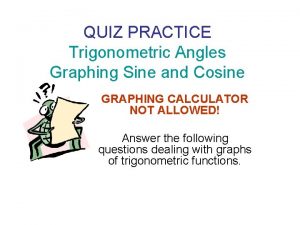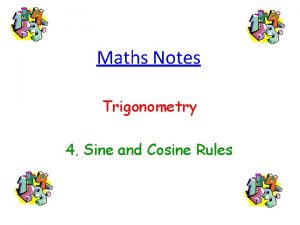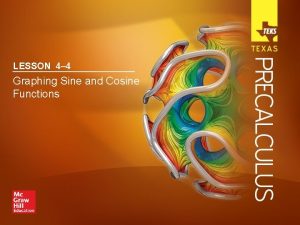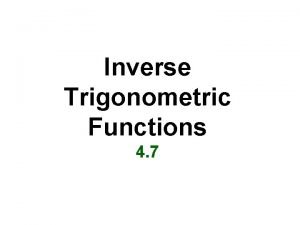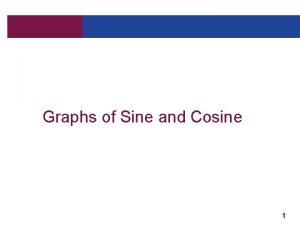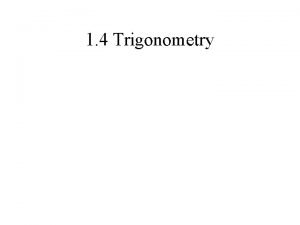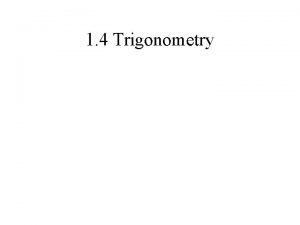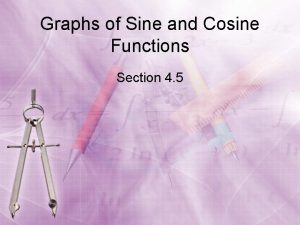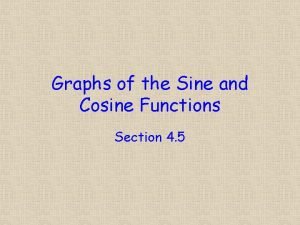Graphs of Sine and Cosine On to Section









- Slides: 9

Graphs of Sine and Cosine On to Section 4. 4

Graphical Analysis: graph the function in the given window Domain: Range: Continuous Alternately increasing and decreasing in periodic waves by Bounded Symmetry: Origin (odd function) Absolute Max. of 1 No Horizontal Asymptotes End Behavior: Absolute Min. of – 1 No Vertical Asymptotes and do not exist

The “Do Now” – first, graph the function in the given window Other notes: • This function is periodic, with period by • By definition, sin(t) is the y-coordinate of the point P on the unit circle to which the real number t gets wrapped So now let’s “explore” where this wavy graph comes from…

Exploration – Graphing sin(t) as a Function of t Set your calculator to radian mode, parametric, and “simultaneous” graphing modes. Set Tmin = 0, Tmax = 6. 3, Tstep = Set the (x, y) window to [– 1. 2, 6. 3] by [– 2. 5, 2. 5] Set X 1 T = cos(T) and Y 1 T = sin(T). This will graph the unit circle. Set X 2 T = T and Y 2 T = sin(T). This will graph sin(T) as a function of T.

Exploration – Graphing sin(t) as a Function of t Now start the graph and watch the point go counterclockwise around the unit circle as t goes from 0 to in the positive direction. You will simultaneously see the y-coordinate of the point being graphed as a function of t along the horizontal t-axis. You can clear the drawing and watch the graph as many times as you need in order to answer the following questions. 1. Where is the point on the unit circle when the wave is at its highest? at the point (0, 1) 2. Where is the point on the unit circle when the wave is at its lowest? at the point (0, – 1) 3. Why do both graphs cross the x-axis at the same time? Both graphs cross the x-axis when the y-coordinate on the unit circle is zero.

Exploration – Graphing sin(t) as a Function of t Now start the graph and watch the point go counterclockwise around the unit circle as t goes from 0 to in the positive direction. You will simultaneously see the y-coordinate of the point being graphed as a function of t along the horizontal t-axis. You can clear the drawing and watch the graph as many times as you need in order to answer the following questions. 4. Double the value of Tmax and change the window to [– 2. 4, 12. 6] by [– 5, 5]. Change the grapher “style” to show a moving cursor. Run the graph and watch how the sine curve tracks the y-coordinate of the point as it moves around the unit circle. 5. Explain from what you have seen why the period of the sine function is.

Exploration – Graphing sin(t) as a Function of t Now start the graph and watch the point go counterclockwise around the unit circle as t goes from 0 to in the positive direction. You will simultaneously see the y-coordinate of the point being graphed as a function of t along the horizontal t-axis. You can clear the drawing and watch the graph as many times as you need in order to answer the following questions. 6. Challenge: Can you modify the calculator settings to show dynamically how the cosine function tracks the x-coordinate as the point moves around the unit circle? Leave all previous settings the same, except change Y 2 T to cos(T). . check the graph!!!

Now, a Complete Analysis of the Cosine Function Domain: Range: Continuous Alternately increasing and decreasing in periodic waves by Bounded Symmetry: y-axis (even function) Absolute Max. of 1 No Horizontal Asymptotes End Behavior: Absolute Min. of – 1 No Vertical Asymptotes and do not exist

Now, a Complete Analysis of the Cosine Function Other notes: • This function is periodic, with period by • By definition, cos(t) is the x-coordinate of the point P on the unit circle to which the real number t gets wrapped Using our transformational knowledge, how does the graph of cos(t) relate to that of sin(t)? ? ? It is a horizontal shift by of the graph of sin(t)
